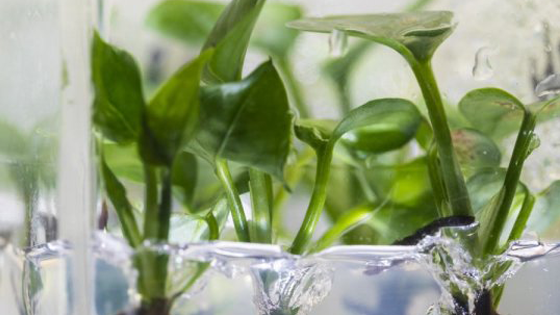New houseplant can clean your home's air

We like to keep the air in our homes as clean as possible, and sometimes we use HEPA air filters to keep offending allergens and dust particles at bay. But some hazardous compounds are too small to be trapped in these filters. Small molecules like chloroform, which is present in small amounts in chlorinated water, or benzene, which is a component of gasoline, build up in our homes when we shower or boil water, or when we store cars or lawn mowers in attached garages. Both benzene and chloroform exposure have been linked to cancer.
Now researchers at the University of Washington have genetically modified a common houseplant -- pothos ivy -- to remove chloroform and benzene from the air around it. The modified plants express a protein, called 2E1 that transforms these compounds into molecules that the plants can then use to support their own growth. The team decided to use a protein called cytochrome P450 2E1, or 2E1 for short, which is present in all mammals, including humans. In our bodies, 2E1 turns benzene into a chemical called phenol and chloroform into carbon dioxide and chloride ions. But 2E1 is located in our livers and is turned on when we drink alcohol. So it's not available to help us process pollutants in our air.
The researchers made a synthetic version of the gene that serves as instructions for making the rabbit form of 2E1. Then they introduced it into pothos ivy so that each cell in the plant expressed the protein. Pothos ivy doesn't flower in temperate climates so the genetically modified plants won't be able to spread via pollen. The researchers then tested how well their modified plants could remove the pollutants from air compared to normal pothos ivy. They put both types of plants in glass tubes and then added either benzene or chloroform gas into each tube. Over 11 days, the team tracked how the concentration of each pollutant changed in each tube. For the unmodified plants, the concentration of either gas didn't change over time. But for the modified plants, the concentration of chloroform dropped by 82 percent after three days, and it was almost undetectable by day six. The concentration of benzene also decreased in the modified plant vials, but more slowly: By day eight, the benzene concentration had dropped by about 75 percent. In order to detect these changes in pollutant levels, the researchers used much higher pollutant concentrations than are typically found in homes. But the team expects that the home levels would drop similarly, if not faster, over the same time frame.
The team is currently working to increase the plants' capabilities by adding a protein that can break down another hazardous molecule found in home air: formaldehyde, which is present in some wood products, such as laminate flooring and cabinets, and tobacco smoke. This research was funded by the National Science Foundation, Amazon Catalyst at UW and the National Institute of Environmental Health Sciences.
Source: https://www.sciencedaily.com/releases/2018/12/181219093911.htm

Image Source : https://www.sciencedaily.com/releases/2018/12/181219093911.htm

